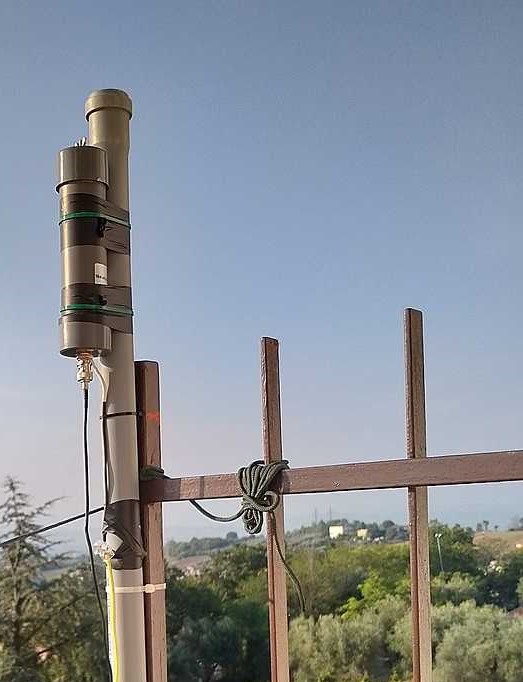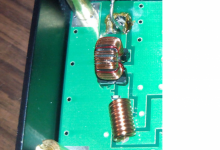below500kc
Member
- Joined
- Nov 19, 2019
- Messages
- 22
As I have made and used both e-probe and vertical antennas, I've been contemplating a situation that I'd like to get some "feedback" on. Ok, here's the way I'm looking at the comparison between the two types of antennas. First, let's try and make it a fair and equal "shootout".
So let's imagine an e-probe and vertical setup like this:
The e-probe:
Sitting on top of a conductive 20ft. mast
Underneath the mast is a shallow buried radial system... 6 wire radials 20 ft. long with a wire circularly connecting all of them together at the far end. Mast connected to radial system.
The "ground" of the e-probe directly connected to the conductive mast. The coax running up along the mast must pass through a common mode choke at the e-probe base before connecting to same.
100ft of coax running along the ground/earth into the shack to meet the bias-tee and receiver.
This system will need to perform decently between 100khz and 30 mhz.
The vertical:
A 20ft. conductive mast with the same ground system as the e-probe, insulated at the base from that ground system.
An impedance step-up auto-transformer made from an appropriate low freq material that will allow non-resonant broadband rx from 100khz to 30 mhz. Let's give it, for example, a 49:1 turns ratio.
The transformers primary will be placed across the coax at the base of the mast and grounded to the wire system. The one secondary wire will tie to the mast vertical.
Same run of coax to the shack to the receiver minus the bias-tee.
Ok, with that out of the way, here's where I'm going with this...
It's my belief that there is really no advantage to using an e-probe over the simple vertical. You would also have a small increase in noise level using the e-probe over the vertical since there will always be a small amount of noise generated by the amplification in the probe. If the probe is not well designed, you also run the risk of intermodulation if in a relatively dense RF surrounding with AMBCB stations. Of course, you also have to expend a small amount of dc power to run the probe.
You may say that the vertical may perform poorly at 30mhz due to the loss of 100 ft. of coax. However, if the receiver at the other end "notices" an increase in noise level when the coax is connected, the level of snr will be adequate for reception with that receiver.
I use both antenna types, but I feel that there's no advantage to an e-probe when used as above. I think an e-probe would "shine" if it were used on a metal surface such as a roof used as the counterpoise.
Any thoughts on this comparison would be welcomed... pro or con.
Ray
So let's imagine an e-probe and vertical setup like this:
The e-probe:
Sitting on top of a conductive 20ft. mast
Underneath the mast is a shallow buried radial system... 6 wire radials 20 ft. long with a wire circularly connecting all of them together at the far end. Mast connected to radial system.
The "ground" of the e-probe directly connected to the conductive mast. The coax running up along the mast must pass through a common mode choke at the e-probe base before connecting to same.
100ft of coax running along the ground/earth into the shack to meet the bias-tee and receiver.
This system will need to perform decently between 100khz and 30 mhz.
The vertical:
A 20ft. conductive mast with the same ground system as the e-probe, insulated at the base from that ground system.
An impedance step-up auto-transformer made from an appropriate low freq material that will allow non-resonant broadband rx from 100khz to 30 mhz. Let's give it, for example, a 49:1 turns ratio.
The transformers primary will be placed across the coax at the base of the mast and grounded to the wire system. The one secondary wire will tie to the mast vertical.
Same run of coax to the shack to the receiver minus the bias-tee.
Ok, with that out of the way, here's where I'm going with this...
It's my belief that there is really no advantage to using an e-probe over the simple vertical. You would also have a small increase in noise level using the e-probe over the vertical since there will always be a small amount of noise generated by the amplification in the probe. If the probe is not well designed, you also run the risk of intermodulation if in a relatively dense RF surrounding with AMBCB stations. Of course, you also have to expend a small amount of dc power to run the probe.
You may say that the vertical may perform poorly at 30mhz due to the loss of 100 ft. of coax. However, if the receiver at the other end "notices" an increase in noise level when the coax is connected, the level of snr will be adequate for reception with that receiver.
I use both antenna types, but I feel that there's no advantage to an e-probe when used as above. I think an e-probe would "shine" if it were used on a metal surface such as a roof used as the counterpoise.
Any thoughts on this comparison would be welcomed... pro or con.
Ray



